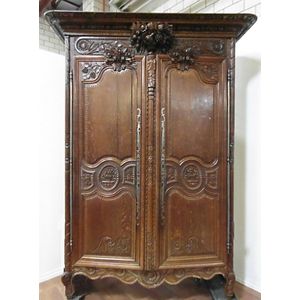William IV Mahogany Sideboard with Lion Feet
You must be a subscriber, and be logged in to view price and dealer details.
Subscribe Now to view actual auction price for this item
When you subscribe, you have the option of setting the currency in which to display prices to $Au, $US, $NZ or Stg.
- Pedestal - The columns that support many dining tables and most small occasional tables. They are usually turned, though octagonal-shaped pedestals were fashionable during the 1830s and 1840s.
- Monopodia / Monopodium - A monopodia / monopodium is a leg or support on furniture or other item, formed from the head and leg of an animal, usually a lion. This style of support became popular in the Regency period when it was used on tables, sideboards and occasionally cabinet furniture.
- Monopodia - A monopodia is a support on an item of furniture comprising an animal's head and a leg, and was in use during the Regency period in England.
- Mahogany - Mahogany is a dense, close grained red-coloured timber from the West Indies and Central America. It was first imported into Europe in the the early 18th century and its use continued through the 19th century. It was popular for furniture making because of its strength, the wide boards available, the distinctive grain on some boards, termed flame mahogany and the rich warm colour of the timber when it was polished.. The "flame" was produced where a limb grew out from the trunk of the tree, and this timber was usually sliced into veneers for feature panels on doors, backs and cornices.
Some terms used to describe mahogany relate to the country from which it originally came, such as "Cuban" mahogany, "Honduras" mahogany etc. However unless the wood has been tested the names assigned are more a selling feature, rather than a true indication of the timber's origin. - William Iv - William IV was King of the United Kingdom and King of Hanover from 26 June 1830 until his death in 1837, and in English furniture design it represented the brief period between the end of the Regency period, and the beginning of the Victorian period.
This item has been included into following indexes:
Visually similar items

A Colonial Australian cedar sideboard, full cedar secondaries, from the workshop of James Whitesides of Hobart, circa 1840, 148 cm high, 214 cm wide, 72 cm deep

A Victorian flame mahogany sideboard, 19th century, with a shaped arching back with generous scrolling vegetal edges, three ogee profile frieze drawers above pedestal cupboards with applied bead borders and fleur-de-lis decorations, one cupboard fitted wit

A William IV mahogany sideboard, the top with inverse breakfront, shell and scroll carved upstand back, raised above a frieze with three drawers, supported on two pedestals, the right-hand pedestal enclosing a cellarette drawer. 175 cm x 57.5 cm x 114 cm

A Continental 19th century ornately carved oak two door armoire, having original iron hardware. 240 cm high, 146 cm high, 48 cm deep
